Ukraine is slowly descending into a panic regarding the collapse of the Donbass front, and in fact that collapse is seemingly accelerating. Some semblance of a normalcy bias continues to grip the more obdurate observers, but the keen-eyed are seeing the writing on the wall.
Head of the top Ukrainian channel “Deepstate UA”—which is basically the Ukrainian ‘Rybar’—calls the situation complete chaos:
Arestovich wrote a long post on his official account where he called the situation around Pokrovsk an “operational crisis”.
Rada deputy Goncharenko was beside himself, calling the situation catastrophic. He added that after Pokrovsk, the road to the entire Dnieper will be wide open:
It’s almost pointless even updating the exact captures and advances anymore because right now they’re simply happening so fast that within hours of the Sitrep’s release, the information is already obsolete, and Russians have advanced even more. But suffice it to say, this time there were even several major captures in areas other than Pokrovsk.
Russian forces captured the remainder of Konstantinovka on the Ugledar line:
Ugledar is now becoming in danger of being surrounded for the AFU in the near future.
Ukrainian military channel:
Then Russians captured most of Grodovka, after having just entered it days ago:
At this pace, it will be captured in the next day or two it seems.
After capturing New York, they’ve already entered the next settlement north of it, Nelipovka. And nearby, they’ve advanced deeper into Toretsk, gaining hundreds of meters inside the important city.
As of now, they’re mere kilometers from Pokrovsk, and right at the outskirts of its neighboring city of Mirnograd:
Nearby, they’ve now entered Selidov for the first time, and are already working through it:
UA account:
Another Ukrainian account:
"Battles for Selidove have begun! The enemy is actively pushing our defenses on the eastern outskirts of the city, the fighting continues in the area of the stadium and the park, slowly moving towards the high-rises, also the podars are trying to level the front and are starting to press from Mykhailivka to the south and push from the highway in the east. The same squeeze situation occurred in New York."
‘Celery’ above is meant to be Selidove.
As of this writing, there’s already word that Russian forces have begun storming Mirnograd:
Here’s the best current write up with good maps of the Pokrovsk situation from one of the more level-headed and critical-thinking Ukrainians, Tatarigami: https://euromaidanpress.com/2024/08/28/what-the-fall-of-pokrovsk-could-mean-for-ukraine/
In light of the ongoing collapse, the potential for dangerous escalation rises because Zelensky gets increasingly desperate to engineer some kind of black swan event that could overturn the table and upend events.
With this in mind there continue to be a slew of rumors for what Zelensky’s next move might be. For instance, there continue to be reports of AFU preparations on the Zaporozhye front:
There is some credence to the above given that in the past few days the Russian airforce has carried out at least 2 separate air strikes along the Black Sea toward Odessa—one was at Snake Island, and another at oil platforms just east of there which Ukrainian GUR was using to stage landings toward Crimea.
This is roughly how Zelensky’s potential plan is meant to play out:
A simultaneous mass landing by special forces around the Kinburn Spit area to harass the ‘rears’ of Russia’s Dnieper grouping, while other amphibious forces directly strike at the Energodar plant and then the main logistics force tries to wrap around from Zaporozhye city along the river to connect with them.
There’s an undercurrent of tension now running through events as other somewhat peculiar happenings have gone on. For instance, Belarus suddenly moved a lot of forces to the Ukrainian border again, and for the first time they appear to have a tactical symbol of a ‘B’ on them, as if they are preparing for direct combat:





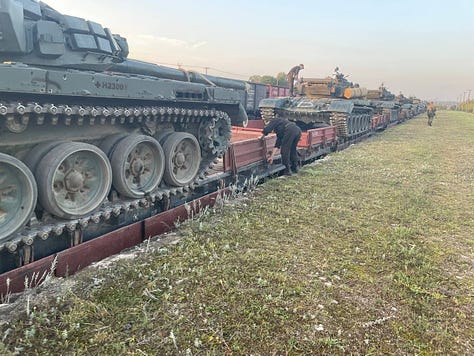



No one quite knows why this happened, but there are a few potential conjectures:
Lukashenko foresees Ukraine attempting to create some provocation as part of the earlier mentioned ‘black swan’ to involve NATO forces, and is taking appropriate deterrence measures
Lukashenko is trying to help Russian troops by pinning or ‘fixing’ Ukrainian border guards along the Belarus border, given that Ukraine was said to have removed many of the border forces to use them in Kursk
Least likely: Russia and Belarus plan some kind of joint final decapitation invasion to finish off the war
Most likely it’s a combination of 1 and 2.
Partly related to the heightening tensions, we now have a new very interesting statement by Lavrov which appears to vindicate my recent reporting about potential changes to the Russian nuclear doctrine, given the West’s unceasing escalations against Russia’s red lines.
Recall the recent piece:
Well, lo and behold, at his latest press conference, Lavrov just stated that Russia is currently “fine tuning” or “refining” its nuclear doctrine—what could that mean?
Listen closely at 0:35:
From the RT article:
Russia’s nuclear doctrine allows the deployment of the weapons in retaliation for a first strike by the enemy or when the existence of the Russian nation state is at risk. The government has indicated in recent months that the key document may be altered in the face of what it perceives as an existential threat posed to Russia by NATO.
I think it’s only natural given that Ukraine is on the final precipice of potentially being given permission to use intermediate range strategic weapons against Russian strategic sites—i.e. ATACMS, Storm Shadows, etc., potentially hitting deep Russian bases, nuclear plants, or even Moscow itself. Furthermore, the introduction of the F-16 into Ukraine, which is nuclear-capable, and which Russia must doctrinally treat as a possible nuclear threat if it ever comes close to Russian borders.
As such, it’s par for the course that Russia will likely have to adjust its doctrine to allow for some kind of limited nuclear response in accordance with the training doctrines I outlined in the paywalled piece above.
And for the careful listeners, you’ll note Lavrov seemed to drop a hint about what the doctrinal changes could be. He said in the same video above that Americans think they will be safe from a nuclear war in Europe, but that Russia is adjusting its doctrine. The hint seems to imply that if America stokes some type of nuclear exchange within Ukraine, then Russia may have to look at direct nuclear strikes at the US itself as part of its response.
Another analysis on the situation:
Russian telegram channel "Pinta of Reason" (https://t.me/pintofmind/3892):
According to the latest statements by Sergey Lavrov, Russia is currently clarifying its nuclear doctrine. It is clear that this was said in response to the circulating information about the negotiations currently underway between the United States and Ukraine regarding Washington's permission to strike Russian territory at strategic depth.
There is only one unpleasant thing here: how could Moscow have gotten to the point where such American-Ukrainian negotiations became possible? This simply should not have happened if Russia had adequately responded to the escalation from Ukraine's Western allies. But Moscow has chosen the tactics of the notorious "red lines", which are now gradually turning into an incomprehensible vinaigrette. That is, they are slowly being crossed and moved on.
The only way to change the situation now is through an escalation that is ahead of schedule. That is, the stakes will have to be raised sharply, unilaterally, and higher than the US and EU countries have done. Of course, we are talking about nuclear weapons. What is needed now is not just vague statements that Russia reserves the right to attack some NATO facilities in the event of long-range weapons strikes on its strategic facilities.
It is now necessary to declare that in the event of such attacks, Russia will immediately and without fail strike military facilities of countries supplying weapons to Ukraine. And if the North Atlantic Alliance reacts in response, it will respond with nuclear weapons (initially limited, in a tactical manner).
That is, the Biden administration and the Brussels bureaucracy must be clearly presented with a choice: either a limited nuclear war in Europe (with a possible expansion of the theater of military operations), or a refusal to use NATO weapons against Russia to a strategic depth.
As a result, the "red lines" of the collective West will be tested: will they agree to a limited nuclear war? Are the US and its European allies ready to risk their existence for the sake of Ukraine? Let us recall that Washington faced a similar dilemma (of course, in relation to the European members of NATO, not Ukraine) in the distant 1960s, and then the answer to the answer was unambiguous: no, not at all. Now, little has changed.
I don’t fully agree with it, but present it here for reflection. Just as NATO has adopted a deliberate strategy of “strategic ambiguity”, Russia too can be argued to profit from its own strategic ambiguity in letting the enemy guess what the response can really be. If Russia were to precisely outline its exact red lines and the response their trampling would provoke, then it would potentially give the adversary the chance to fully prepare its own counter-response so that they will remain a step ahead. If it gets down to actual nuclear war, it’s best to have the element of surprise so you win and survive, rather than telegraphing your exact moves to your enemy so that he has a full response package already waiting to neutralize you in the event.
No one strategy is necessarily exactly right, but it’s simply something to think about—each has its pros and cons.
As a final note, the US has concocted an interesting excuse to keep Zelensky at bay:

They’re effectively saying Ukraine doesn’t need to do long range strikes because Russia has moved its planes out of the ATACMS’ range and that Ukraine will have better luck using drones to strike Russian territory:
The U.S. official also told the WSJ that Ukrainian forces may have better success striking Russian airbases using its own long-range drones.
It’s mostly a cop out to ensure Ukraine doesn’t do anything stupid in pulling the US into a nuclear war. The ATACMS/HIMARS system may be one of the few that the US can actually control to keep Ukraine from using it in unauthorized ways, as US officials had previously revealed HIMARS were once hard-coded to not be able to strike Russian territory; the system simply would not allow Ukraine to set a target within Russia—and they may now have done the same for the ATACMS.
—
By the way, it’s pretty humorous how almost in unison, several outlets again take up the brittle coordinated psyop to pretend that Putin is close to toppling due to the failed Kursk fiasco:
The Telegraph piece is particularly egregious, it conjures up a totally surreal fraud so breathtaking it has to be read to be believed. The Ukrainian Kursk offensive is a master class which has resulted in the capture of 3,000+ Russian conscripts—yes, 3,000—and the encirclement of another 3,000 in a cauldron. They are literally just writing fantasy literature at this point.
But the one key piece at the heart of it all is the big tell as to the real strategy of Zelensky’s aims:
But all these are, as I say, subordinate objectives. Zelensky knows that the surest way to end the war is to topple Putin, who has a mystical longing to establish some kind of protectorate over Kyiv, which he sees as the birthplace of Russia. Yes, Putin is also motivated by hunger for the energy reserves under Donbas and in the waters off Crimea. But even if the annexation of his four Ukrainian oblasts were recognised, he would not rest until Kyiv acknowledged Russian suzerainty, at least in foreign policy.
Ukraine’s strategy, then, is to make the war unpopular with Russians. Everyone in the former USSR remembers the conscription riots that preceded the withdrawal from Afghanistan in 1988. That war had claimed 15,000 Soviet lives in ten years. This one is estimated to have claimed ten times as many in a quarter of the time.
It ends on this capstone which perfectly encapsulates everything we’ve been writing here for months—that the only goal of this war was not to defeat the Russian army but to foment the conditions of a coup against Putin, so that a CIA-appointed leader can again take over Russia and drive it to its demise:
The second Kiev Post piece follows this line and underscores it by likening the current crop of exiled Russian liberals to Lenin on the eve of the revolution, ready to swoop back into the country to take the reins from its deposed Tsar:
Some politicians can carefully study Russia’s successful experience of acceding to power from abroad – the activity of Vladimir Lenin. A marginal political group, using successful agitation in a disintegrating army and appealing to the same dark sides of the soul of the overwhelming majority of the illiterate population, picked up the power that had collapsed for entirely different reasons. And it created a terrible totalitarian regime, the consequences of which we shall continue to endure for years.
You can clearly see where they’re going with this.
The article ends on a similarly hopeful note:
But just because we know their plan doesn’t mean it’s entirely shortsighted or unworkable. The truth is, the Kursk incursion has generated some discontent in Russian society; this is simple fact. And the reason is, the handling of it has been fairly incompetent by Putin and his staff.
Ultra-patriot Sladkov visited Kursk and the Belgorod region recently, and himself reported about the “unpleasant” reaction of many citizens, who are wondering, in effect, where the hell is the government and why it has abandoned them:
Russian political scientist Sergei Miheev also touched on this on the Soloviev Live show:
Similarly, recent polls have shown Putin’s inviolable approval rating has just taken a big hit, tumbling for the first time in a year of swooning national pride:
However, that does not mean Putin is even close to being in danger. In fact, the war has apparently been so good for Russia that an entirely new Russian middle class is emerging from it shadows:
The war in Ukraine is creating a new middle class in Russia. Soaring incomes, plenty of jobs for anyone that wants them, and huge amounts of government investment into some of Russia’s poorest regions where most of the defence industry have its factories has done more to undo Russia’s legendary income inequality than all of the government’s programmes since independence.
Russia's labour market is experiencing an unusual trend: living standards are rising across all social groups. Ironically, the war has been good for Russia and sanctions and a showdown with the US have made it stronger.
Real wages continue to exceed inflation rates. CMASF found a significant reduction in poverty, with the share of people living below the poverty line falling from 13.5% in 2016 to 8.5% in 2023 – significantly less than almost all EU countries.
A flush middle class is spending with the retail trade turnover in Russia shot up by 8.8% y/y during the first six months of 2024 to $299.3bln according to Rosstat.
This has been corroborated by other recent surveys showing Russian life satisfaction is peaking at record highs, while dissatisfaction is plummeting to all-time lows. The image translator couldn’t quite get the colors below, but the blue line is ‘quite satisfied’, green is ‘partly satisfied’, and red is ‘absolutely not satisfied’:
The number of people dissatisfied with what is happening in Russia has dropped to a historic low
Only 12% of respondents to the July poll by the Levada Center* said they were not satisfied with the life they were currently leading. This is the lowest figure ever.
And that’s from the pro-Western NGO ‘Levada Center’ at that.
In conclusion: Ukraine’s thinking is admirable—after all, toppling Putin is a far more rationally plausible goal than defeating the Russian Army on the battlefield. But despite some setbacks and minor reputational hits, there’s very little chance it will ever come to pass. It’s more realistic that Putin might one day fire Gerasimov if such blunders keep accumulating rather than the Russian populace ‘rising up’ against Putin himself.
A few last sundry items.
Alexander Kharchenko warns how Ukrainian tactics are beginning to become painful for Russian long range recon UAVs:
We cannot remain silent about this problem. The enemy is increasing its efforts to destroy our reconnaissance UAVs. I won't tell you the figures, but even within a single unit they can be substantial. Before, a drone could work for several months, and now....
Remember how in winter the enemy complained about the lack of anti-aircraft missiles? Our drones felt at ease in the sky. Now FPV drones have started to play the role of interceptors. There's no magic here. The Ukrainians set up radars, planted calculations, created a unified system and began to shoot down our drones.
This problem must be taken extremely seriously. Without reconnaissance UAVs, our reconnaissance and strike circuits will not work. Artillery, Iskanders and FABs will drastically reduce their effectiveness if the enemy clears their skies. The Ukrainians are stepping up their efforts, while we are lagging far behind in destroying UAVs with FPV drones. The main advantages of such air defense means are cheapness of the interceptor, mobility, stealth and high survivability of calculations.
The whole point is that neither we nor the enemy can protect scouts in the sky. And we can only outrun the enemy by the numbers of destroyed UAVs. Since our drones are falling, the enemy's “wings” should not fly either. This way we will maintain the status quo and prevent the enemy from getting ahead in the technological race.
Alexander Kharchenko
This is another area where Ukraine is ahead of Russia—a systematized method of targeting Russian high altitude recon UAVs. Such a thing doesn’t happen by ‘accident’ or opportunistically—there is clinical intent and military organization behind it. Special units are formed with special equipment, tasking, etc. Ukraine is very serious about getting the most out of their FPVs in every aspect of the war.
—
On the other hand, Russia’s remarkable new Knyaz Vandal Novgorod fiber-optic drone continues to haunt the AFU in Kursk, leaving a ‘road of death’ of Ukrainian vehicles in its wake:
In fact, Ukrainian vehicles now litter the Kursk grounds everywhere:
—
Soros was in Kiev again, with dark prince Yermak proudly posting the meeting on his official account (AI translation):
Notice he says the meeting was about the implementation of the “peace formula”. So, Soros is now being given a direct seat at the table in Ukraine’s negotiations?
Just continuing the family business, I suppose:
—
Head of Ukraine’s hydroelectric energy grid says that Russia has hit every single hydroelectric power station in the entire country at this point:
⚡️There is not a single hydroelectric power station in Ukraine that was not attacked by Russia, said Igor Sirota, CEO of Ukrhydroenergo.
"More than 130 missile strikes were carried out on our generation," Sirota said.
According to him, Ukrainian hydroelectric power stations lost about 40% of their generation, and thermal power plants - more than 80%.
—
New 2S19 Msta-Ss are heading to the front :
Meanwhile, Russia tests out the new robotized D-30 artillery:
—
This was a story from several weeks back I forgot to include, but it’s too good not to share. Remember when Ukraine desecrated the Soviet statue? Now Ukrainian news reports their hastily fashioned trident crest made from special heroic “Ukrainian steel” is already rotting and in danger of falling off—call it karma!
Before and after:
—
An interesting series of events. Russian forces apparently identified where Ukraine was storing its F-16s via a PR video where a hint of a building was seen over the officer’s shoulder, circled in red below:
This allowed geolocation of the storage site to an Ivano-Frankovsk airfield.
Following that, during yesterday’s massive strikes, the Russian MOD reported hitting the airfield hangars and the ‘potential’ destruction of 2 stored F-16s, though it wasn’t confirmed and was still being clarified.
Now, there’s word that a top Ukrainian pilot known to have been enrolled in the F-16 training program was killed in the strikes, as confirmed by the Ukrainian side, leading to the speculation that at least one F-16 and its crew was in fact hit on the ground:
Likewise, in the recent Russian Iskander strike on the ‘Aurora’ hotel in Krivoy Rog, widely decried as a “strike on civilians”, we now learn from Ukrainian sources that an SBU colonel and mercenary were amongst the killed, validating the Russian MOD’s version that a secret grouping of officers was hit at the hotel:
New details of the day before yesterday's attack on the hotel Aurora in Krivy Rog The deceased civilians suddenly turned out to be SBU Colonel Cherkashey Sergey Sergiychuk and some Polish mercenary who served in the ranks of the Ukrainian Armed Forces named Vlodek; the identity of the third deceased mercenary is still being kept secret.
—
A note from the X-Files:
Top credible Ukrainian radioelectronics channel reports:
I receive a third letter from our military. A silent thing on the front lines shines a green beam (photo) at our positions. Sometimes it accompanies the equipment with a beam.
From a military point of view, this whole process is incomprehensible.
Are aliens playing pranks?
After publishing the report, he follows up:
I didn't expect such a reaction, dozens of soldiers wrote to me that they saw this green thing.
With another photo a soldier sent him, which shows some equipment near the soldier’s position being illuminated from above by the mysterious green light:
What could it be? (Cue spooky theremin music)
—
Lastly, for the old salts amongst our readership, you’ll be happy to hear Russian frontline commanders report the perfect soldier is a miner or laborer worker in the ripe age group of 50-60 or so—there are no better soldiers, he says:
Your support is invaluable. If you enjoyed the read, I would greatly appreciate if you subscribed to a monthly/yearly pledge to support my work, so that I may continue providing you with detailed, incisive reports like this one.
Alternatively, you can tip here: buymeacoffee.com/Simplicius

















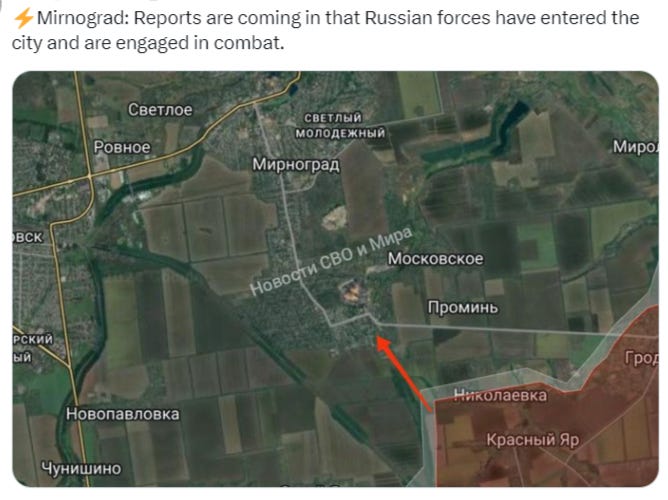

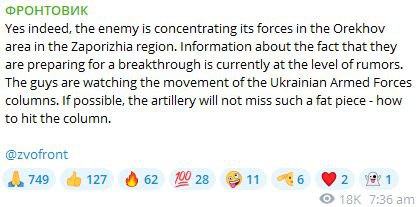


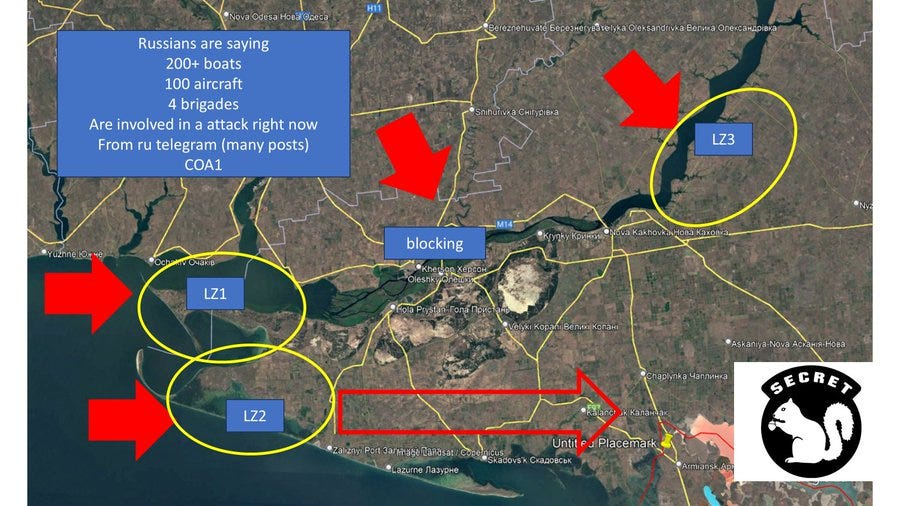




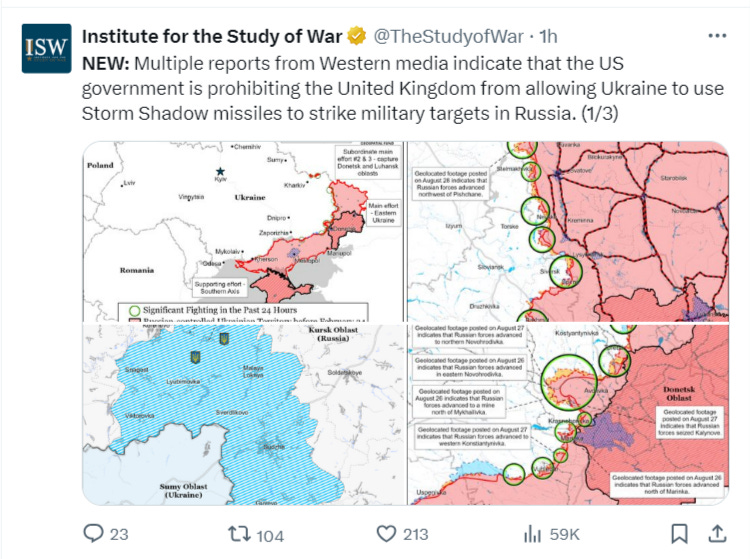




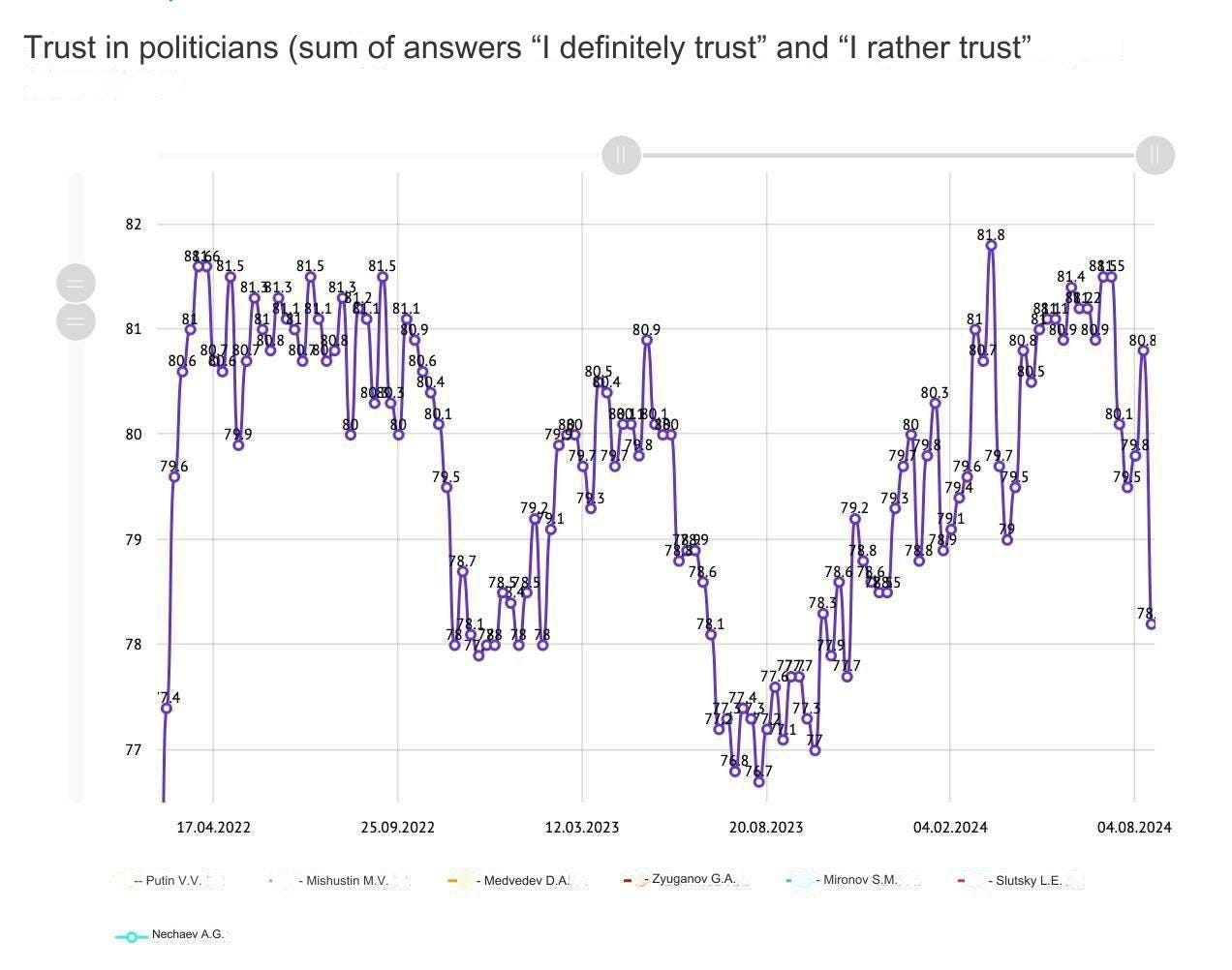

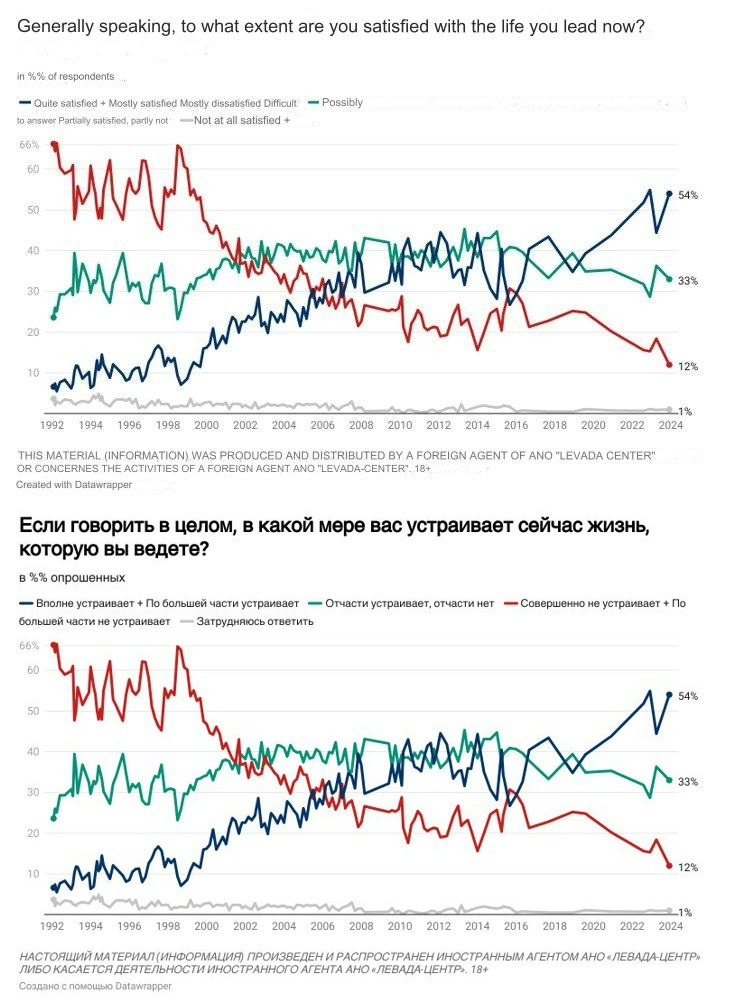


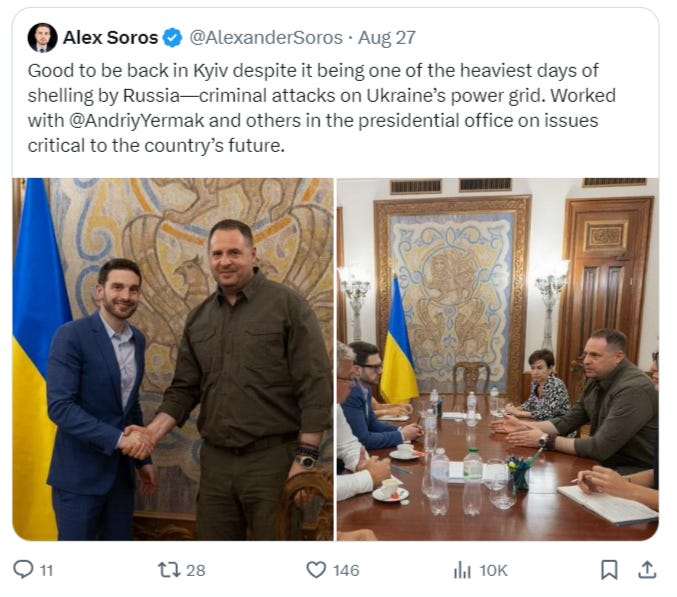

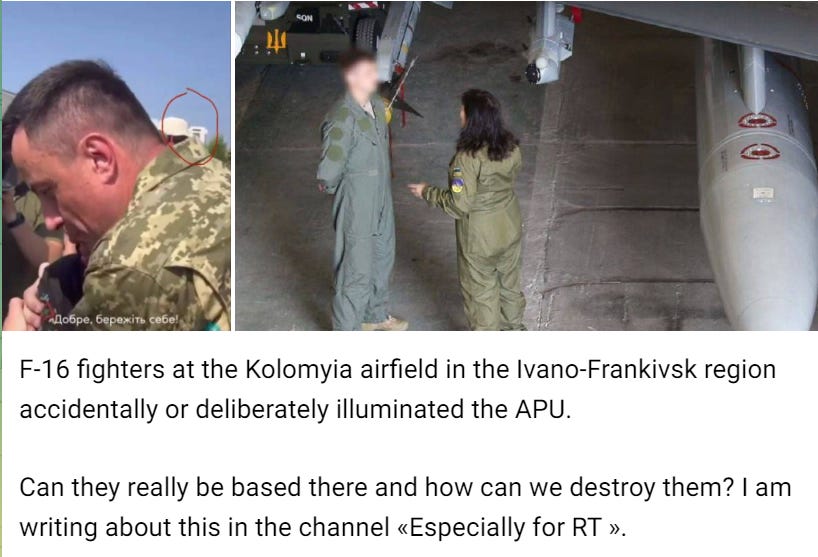
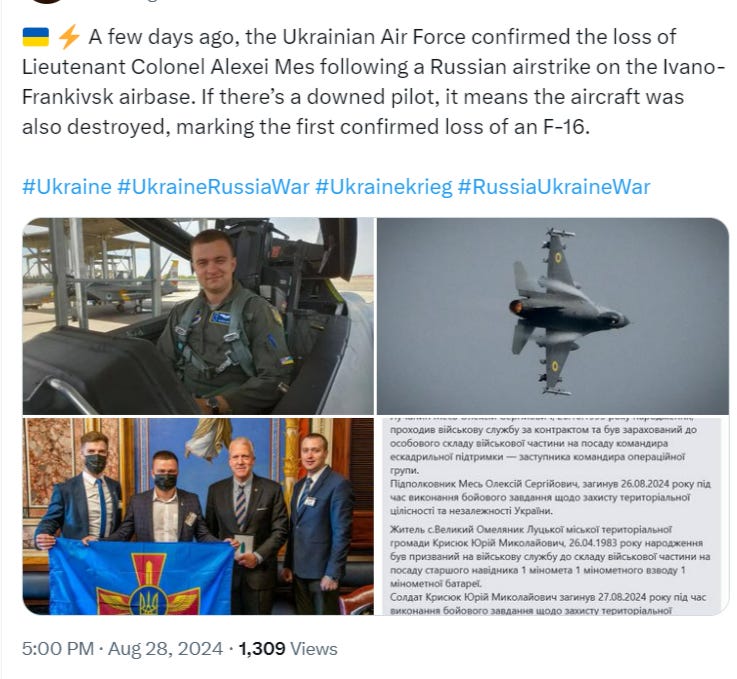


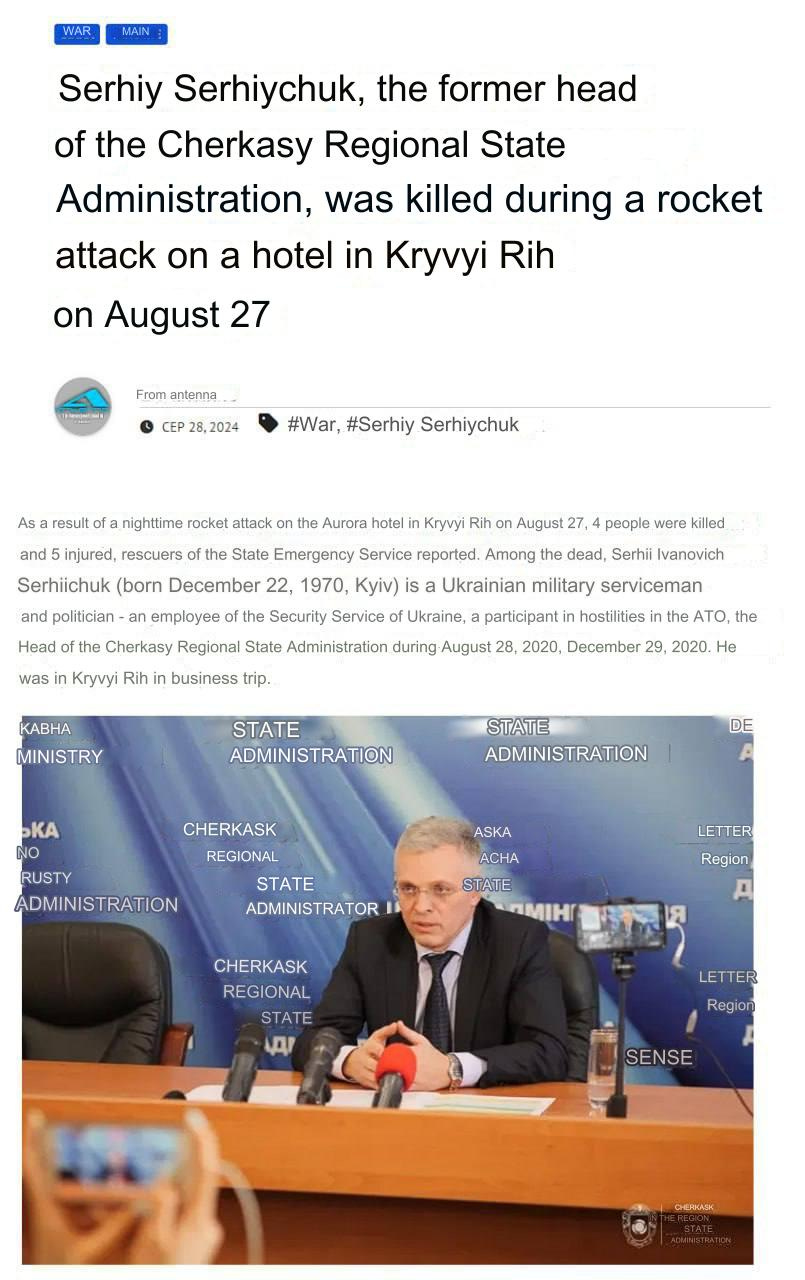

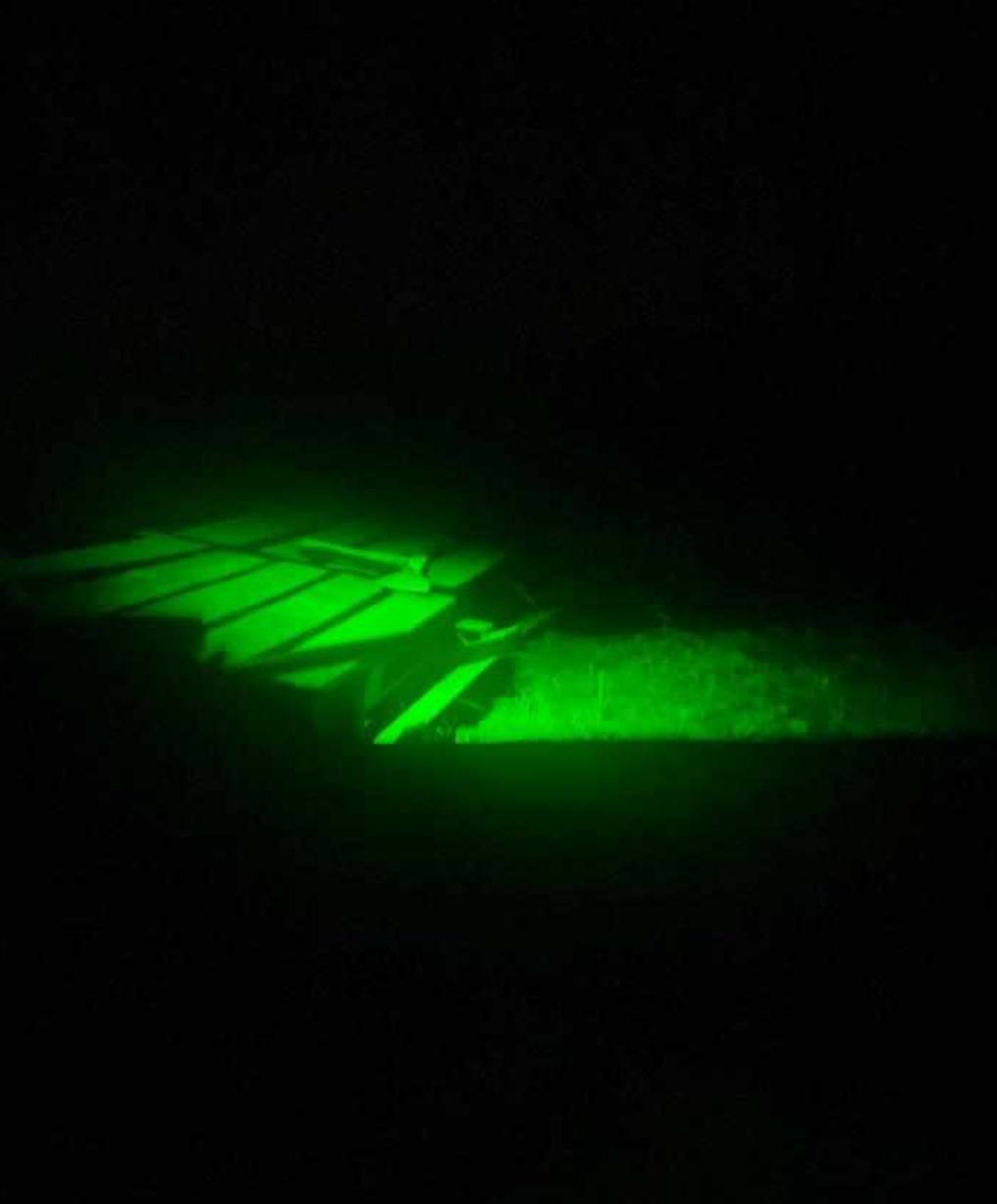
The Telegraph is just an MI6/CIA mouthpiece. Their reporting along with that of the Kiev Post confirms my suspicion that the entire purpose of the Ukraine war was to try a CIA-style overthrow of Putin and that Prigozhin's hair-brained putsch was the overthrow that the CIA intended. The whole thing is so silly, as though Russia were some former British colony that had gone rogue. Amazing how the Soros clan appears everywhere the West seems to be off the rails: truly the devil's agent that fellow.
that there was some scrambling done by ' Putin and his staff ' at the beginning of the Kursk invasion and now his popularity has plummetted....geesh- is a war supposed to be easy ? People inside Russia are as bad as people on fartbook about thinking they know better than Putin and his staff. Makes me mad, even though I'm merely Canadian. During war the population needs to shut the fuck up and be ready. Ludmilla too, is stirring the pot and its not in any of their best interest to do that during times like this. I wish I was in Russia now and not Canada. I'm so ashamed of my government and yet I'm old and poor and have animals I would never abandon, so I stay. But if those foolish Russian complainers and judges could feel what its like to be in a country where your own government wants to depopulate you, they should blush with shame.